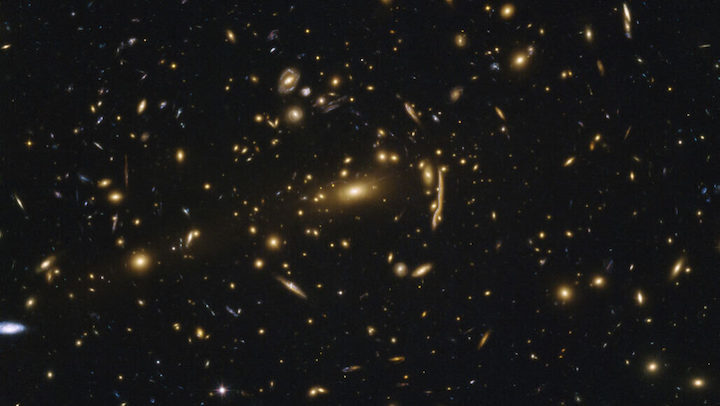11.09.2020
Not only is the mysterious substance invisible, but it’s also not all where we thought it was

Observations of 11 galaxy clusters, such as MACSJ1206.2-0847 (shown), reveal that some globs of dark matter in these clusters are denser than expected.
Dark matter just got even more puzzling.
This unidentified stuff, which makes up most of the mass in the cosmos, is invisible but detectable by the way it gravitationally tugs on objects like stars. (SN: 11/25/19). Dark matter’s gravity can also bend light traveling from distant galaxies to Earth — but now some of this mysterious substance appears to be bending light more than it’s supposed to. A surprising number of dark matter clumps in distant clusters of galaxies severely warp background light from other objects, researchers report in the Sept. 11 Science.
This finding suggests that these clumps of dark matter, in which individual galaxies are embedded, are denser than expected. And that could mean one of two things: Either the computer simulations that researchers use to predict galaxy cluster behavior are wrong, or cosmologists’ understanding of dark matter is.
Very high concentrations of dark matter can act like a lens to bend light and drastically alter the appearance of background galaxies as seen from Earth — stretching them into arcs or splitting them into multiple images of the same object on the sky. “It’s totally cool. It’s like a fun house mirror,” says astrophysicist Priyamvada Natarajan of Yale University.
Judging by computer simulations of galaxy clusters, clumps of dark matter around individual galaxies that are dense enough to cause such dramatic gravitational lensingeffects should be rare (SN: 10/4/15). Based on cluster simulations run by Natarajan and colleagues, “we would expect to see 1 [strong lensing] event in every 10 clusters or so,” says study coauthor Massimo Meneghetti, an astrophysicist at the Astrophysics and Space Science Observatory of Bologna in Italy.
But telescope images told a different story. The researchers used observations from the Hubble Space Telescope and the Very Large Telescope in Chile to investigate 11 galaxy clusters from about 2.8 billion to 5.6 billion light-years away. In that set, the team identified 13 cases of severe gravitational lensing by dark matter clumps around individual galaxies. These observations indicate there are more high-density dark matter clumps in real galaxy clusters than in simulated ones, Meneghetti says.
The simulations could be missing some physics that leads dark matter in galaxy clusters to glom tightly together, Natarajan says. “Or … there’s something fundamentally off about our assumptions about the nature of dark matter,” she says, like the notion that gravity is the only attractive force that dark matter feels.
Richard Ellis, a cosmologist at the University College London who was not involved in the work, thinks the crux of the problem is more likely in the computer simulations than in the nature of dark matter. “A cluster of galaxies is a very dangerous place. It’s like the Manhattan of the universe,” he says — busy with galaxies whizzing past one another, colliding and getting torn up. “There’s awful physics that goes into predicting how many of these little lensed things they should find,” Ellis says, so the new result “is intriguing, but my suspicion is that there’s something in the simulations … that isn’t quite right.”
Future observations with the upcoming Euclid space telescope (SN: 11/14/17), the Nancy Grace Roman Space Telescope and Vera C. Rubin Observatory (SN: 1/10/20) could help clear matters up, says Bhuvnesh Jain, an astrophysicist at the University of Pennsylvania who was not involved in the work. “These three telescopes are going to produce extremely large samples of galaxy clusters,” he says. That may lead to a new understanding of the physics in these turbulent environments, and help determine whether unrealistic simulations are to blame for this dark matter mystery.
